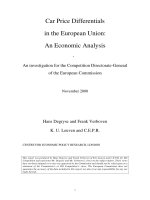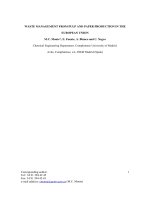Post crisis banking regulation in the european union
Bạn đang xem bản rút gọn của tài liệu. Xem và tải ngay bản đầy đủ của tài liệu tại đây (3.89 MB, 273 trang )
Post-Crisis
Banking Regulation
in the European Union
Opportunities and Threats
Katarzyna Sum
Post-Crisis Banking Regulation in the
European Union
Katarzyna Sum
Post-Crisis Banking
Regulation in the
European Union
Opportunities and Threats
Katarzyna Sum
Warsaw School of Economics
Poland
ISBN 978-3-319-41377-8
ISBN 978-3-319-41378-5
DOI 10.1007/978-3-319-41378-5
(eBook)
Library of Congress Control Number: 2016953881
© The Editor(s) (if applicable) and The Author(s) 2016
This work is subject to copyright. All rights are solely and exclusively licensed by the Publisher, whether
the whole or part of the material is concerned, specifically the rights of translation, reprinting, reuse of
illustrations, recitation, broadcasting, reproduction on microfilms or in any other physical way, and transmission or information storage and retrieval, electronic adaptation, computer software, or by similar or
dissimilar methodology now known or hereafter developed.
The use of general descriptive names, registered names, trademarks, service marks, etc. in this publication
does not imply, even in the absence of a specific statement, that such names are exempt from the relevant
protective laws and regulations and therefore free for general use.
The publisher, the authors and the editors are safe to assume that the advice and information in this book
are believed to be true and accurate at the date of publication. Neither the publisher nor the authors or
the editors give a warranty, express or implied, with respect to the material contained herein or for any
errors or omissions that may have been made.
Cover illustration: © Mark Sykes / Alamy Stock Photo
Printed on acid-free paper
This Palgrave Macmillan imprint is published by Springer Nature
The registered company is Springer International Publishing AG Switzerland
Contents
1
Theoretical Aspects of Banking Regulation
1
2
Basel III: Assessment of the Guidelines for
Regulatory Reform
41
Post-Crisis EU Banking Regulation: Assessment
and Challenges to Implementation
75
3
4
5
6
Bank Governance in the EU: A Substitute or
Complement of Banking Regulation?
133
The Factors Influencing the EU Banking Regulatory
Framework: Impediments for the New Regulations
169
Banking Regulation and Bank Lending in the EU
209
Summary and Conclusions
251
Index
257
v
List of Abbreviations
AIFM
AIFMID
BCBS
BRRD
CDS
CoCos
CRD
CRM
CRO
CRR
CVaR
DGS
DGSD
EBA
EC
ECB
ECOFIN
EDIS
EFP
EFSF
EFSM
EIB
EMIR
ESA
Alternative Investment Fund Managers
Alternative Investment Fund Managers Directive
Basel Committee of Banking Supervision
Bank Recovery and Resolution Directive
Credit Default Swap
Contingent Convertible Bonds
Capital Requirements Directive
Comprehensive Risk Measure
Chief Risk Officer
Capital Requirements Regulation
Conditional Value at Risk
Deposit Guarantee Schemes
Deposit Guarantee Schemes Directive
European Banking Authority
European Commission
European Central Bank
Economic and Financial Affairs Council
European Deposit Insurance Scheme
Employee Financial Participation
European Financial Stability Facility
European Financial Stabilisation Mechanism
European Investment Bank
European Market Infrastructure Regulation
European Supervisory Authorities
vii
viii
ESM
ESMA
ESRB
EU
FCD
FSB
GDP
IASB
IMF
IRC
LCR
LOLR
MIFID
NPL
NSFR
OTC
PIT
ROA
ROE
SSM
SRM
SVaR
TTC
TVaR
UCITS
VaR
VIF
List of Abbreviations
European Stability Mechanism
European Securities and Markets Authority
European Systemic Risk Board
European Union
Financial Conglomerates Directive
Financial Stability Board
Gross Domestic Product
International Accounting Standards Board
International Monetary Fund
Incremental Risk Charge
Liquidity Coverage Ratio
Lender of Last Resort
Markets in Financial Instruments Directive
Non-Performing Loans
Net Stable Funding Ratio
Over The Counter
Point-in-Time Ratings
Return on Assets
Return on Equity
Single Supervisory Mechanism
Single Resolution Mechanism
Stressed Value at Risk
Through-the-Cycle Ratings
Tail Value at Risk
Undertakings for Collective Investment in Transferable Securities
Value at Risk
Variance Inflation Factor
List of Figures
Fig. 2.1
Fig. 3.1
Fig. 3.2
Fig. 3.3
Fig. 3.4
Fig. 3.5
The pillars of Basel III
Sovereign yields of peripheral countries (%)
Total recapitalisation and asset relief state aid used by EU
member states between 2008 and 2014 (% GDP.)
The growth rate of foreign branches’ assets from other
EU countries
The growth rate of foreign subsidiaries’ assets from other
EU countries
Tier 1 capital to assets ratios of EU banks
50
77
80
85
86
120
ix
List of Tables
Table 4.1
Table 5.1
Table 5.2
Table 5.3
Table 5.4
Table 5.5
Table 5.6
Table 5.7
Table 5.8
Table 6.1
Table 6.2
Table 6.3
Table 6.4
Results of empirical studies concerning the impact
of regulation on bank governance
Banking regulatory measures: summary statistics
Banking sector and macroeconomic features:
summary statistics
Correlation of the main variables
Baseline model results (random effects estimation)
Regression results with endogenous covariates
(HT estimation)
Regression results for the dynamic model
(RE estimation)
Test for a structural break after the financial crisis
(RE estimation)
Results for the regressions explaining regulation
changes (RE estimation)
Summary statistics
Correlation of the main variables
Characteristics of banks in the bottom and top
quartile of loan growth
Estimation results for the dependent variable loan
growth during the sample period 2005–14
148
184
186
188
190
191
192
193
194
220
222
224
228
xi
xii
List of Tables
Table 6.5
Table 6.6
Table 6.7
Table 6.8
Table 6.9
Table 6.10
Estimation results for the dependent variable NPL
growth during the sample period 2005–14
Estimation results for the dependent variable loan
growth during the crisis period 2007–10
Estimation results for the dependent variable NPL
growth during the crisis period 2007–10
Estimation results for the impact of regulatory
change on loan growth during the crisis period
2007–10
Estimation results for the impact of regulatory
change on NPL growth during the crisis period
2007–10
Post-crisis regulatory changes
230
234
236
238
240
243
Introduction
The recent financial crisis revealed substantial drawbacks in the banking
regulatory framework of the European Union (EU). The pre-crisis regulations were built mainly on the Basel II guidelines and the harmonised rules
for EU banks based on the Second Banking Directive and the Financial
Services Action Plan. The regulatory solutions turned out to be insufficient to prevent unstable credit booms and to cope with the changing
banking integration patterns and deregulation in the EU banking sector.
EU banks incurred large losses during the recent financial crisis, even
the ones which were based in countries with conservative banking regulations. Commonly blamed factors of the debacle were: insufficiently
stringent and clear capital adequacy rules; the procyclicality of banking
regulations; the inadequate treatment of over the counter (OTC) derivative transactions; as well as the lack of regulations concerning systemic
risk and supranational supervisory mechanisms. Deregulation and the
involvement of banks in securitisation activities have enabled the banks’
business models to change from originate to hold to originate to distribute. Hence, regulators were confronted with highly leveraged banks,
increased opacity of their balance sheets and excessive risk taking in the
banking sector. Moreover, the international interconnectedness of EU
banks has contributed to pronounced systemic risk. One of the most serious concerns of the EU banking sector turned out to be the vicious circle
between the banking and sovereign debt crises. Ailing banks required
xiii
xiv
Introduction
large amounts of government aid; this substantially strained the public
budget of EU countries and increased the riskiness of sovereign bonds
and their refinancing costs. Since government bonds constituted a large
part of the banks’ portfolios, their increased yields weakened further the
banks’ balance sheets and rendered them even more vulnerable to the
crisis.
Regulators reacted to the crisis by introducing far reaching reforms
to the existing frameworks, as well on the national, and supranational,
level. The post-crisis banking regulations in the EU are based largely
on the Basel III framework. They are also geared towards resolving the
EU-specific problems of the banking sector by creating new, supranational, supervisory institutions and bank resolution frameworks which
would help to break the vicious circle between banks’ funding costs and
sovereign risk. The new regulatory acts are aimed at establishing a banking union, a project aimed at resolving the immediate problems related
to the sovereign debt crisis, as well as strengthening the single market
for financial services in the longer term. The banking union entails the
movement of supervisory responsibility and potential financial assistance
for banks to the supranational level. Hence, it is expected to reduce the
fragmentation of financial markets, counteract deposit flights and restore
confidence in the EU banking sector through setting uniform standards
for banking regulation.
The post-crisis regulatory reforms in the EU have provoked an intense
debate among academics, supervisors and representatives of the banking
industry. Contrasting views emerged with regards to the accuracy and
the impact of the new solutions. Hence, the aim of this book is to depict
the main opportunities and threats relating to post-crisis banking regulation and to answer the question of whether or not the new solutions are
an appropriate response to the EU’s ailing banking sector problems. To
approach this question the book addresses several strands of the current
discussion around EU banking regulation: the implementation of Basel
III rules, the introduction of the banking union, the inclusion of bank
governance elements into the regulatory frameworks, as well as the country specific factors of regulation on national levels.
The main contribution of the book is a holistic, economic analysis of
the ongoing banking regulatory reform in the EU. The study adds to
Introduction
xv
the discussion about the controversial issues relating to EU regulations
concerning the accuracy and the impact of the new solutions. An important value added element of the book is the novel approach to banking
regulations, consisting of their endogeneity and interactions with bank
governance. In this way the study contributes to the debate concerning
insufficient bank governance, blamed as one of the triggers of the crisis.
A substantial contribution of the book is also an analysis of the impact
of endogenous factors relating to the features of the regulatory process in
the EU on the implementation of the rules. The study investigates empirically the extent of regulatory capture in EU banking regulation, a topical
issue, which has been barely covered in the literature until now. A further
contribution of the study is the empirical examination of the widely discussed issue of how the new regulations will impact lending. The book
analyses banking regulation in the EU within theoretical frameworks, as
well as by means of empirical exercises. Based on the conducted analyses
it formulates challenges for futures reforms.
The book is structured as follows. Chapter 1 reviews the theoretical aspects of banking regulation, depicts the main tasks of banks and
provides arguments for the need for banking regulation. It discusses the
special status of banks versus other firms, and the resulting need for protection and regulation of the banking industry. Moreover, it analyses the
role of banking regulations within the framework of the agency theory. It
points out the purpose and functions of the respective elements of banking regulations and their importance in maintaining the stability of the
banking sector. Importantly, the chapter focuses on the new post-crisis
paradigm of regulation. Particular attention is dedicated to the newly
evolved, contradictory, strands of the treatment of banking crises in regulations, the issue of the regulation of financial conglomerates and the
Too-Big-To-Fail problem, the regulation of the shadow banking sector,
the approach to systemic and endogenous risk, and the need for international coordination in regulations.
Chapter 2 assesses the post-crisis Basel framework which provides the
main guidelines for the reforms in the EU. It points out its main benefits
and drawbacks in terms of its impact on banking system stability and
subsequently on the liquidity provision function of banks. It particularly addresses the issue of the risk models used for regulatory purpose,
xvi
Introduction
due to their crucial role in determining the banks’ risk. The chapter also
focuses on the controversial aspects of Basel III which mainly include: the
insufficiently addressed large exposures treatment, the portfolio invariance problem, the issue of sovereign risk weighting, as well the possible
arbitrage resulting from the different treatment of the trading and banking book positions and from the possibility of shifting bank promises
between financial institutions.
Chapter 3 describes and assesses the post-crisis banking regulations
in the EU and articulates challenges for ongoing reforms. It portrays
the EU-specific background for the post-crisis reforms. It describes the
vicious circle between the banking and the sovereign debt crisis and the
apparent need to create supervisory and resolution mechanisms to maintain the stability of the euro area. It describes the creation of new banking
supervisory authorities and the most important post-crisis regulations,
directives and proposals in EU banking. It depicts the utility of the new
regulations for the establishment of the main pillars of the banking union:
the Single Supervisory Mechanism and Single Resolution Mechanism. It
also refers to the planned introduction of the Single Deposit Insurance
Scheme which would contribute to the completion of the banking union.
Subsequently, it aims to assess whether the new regulations are an appropriate response to the specific EU banking sector’s problems. It points out
the advantages of the new solutions but also addresses their problematic
aspects including: the controversial interpretation of the Basel recommendation on the regulatory treatment of sovereign exposures; the large
exposures treatment in the EU framework; and the unresolved issues of
the banking union, particularly the insufficient credibility of private sector involvement in the bank resolution process, and the resulting potential participation of taxpayers in absorbing the effects of banks’ failure.
Chapter 4 investigates the interactions between bank regulation and
governance and evaluates the ongoing inclusion of governance elements
in the EU regulatory framework. The chapter outlines the basic functions and elements of bank governance and analyses interactions between
banking regulation and governance within the frameworks of the agency
theory and regulatory dialectics theory. The analysis is aimed at establishing whether bank governance in the EU is a substitute, or complement,
of banking regulation. It also discusses the regulatory acts concerning
Introduction
xvii
corporate governance in banks and aims at assessing the inclusion of
bank governance elements in the EU regulatory framework in terms of
their impact on banking sector stability.
Chapter 5 aims at identifying the determinants of regulations and
their implications for the implementation and conduct of EU rules on
national levels. It describes the regulatory process in the EU with a particular focus on the stakeholders involved in the consultation process and
their impact on the regulatory acts. It approaches the issue of regulatory capture in the EU banking sector, on the national, as well as on the
supranational, level. To determine the factors of regulation it builds on
theories of regulatory choices: the private interest theory, the public interest theory and the regulatory dialectics theory, and conducts a series of
empirical exercises aimed at testing the hypotheses concerning regulatory
factors in the EU. It also analyses the individual cases of the consultation
processes concerning the new, major, banking regulatory acts in the EU
by considering stakeholders’ participation in the regulatory procedure.
Subsequently it points to the opportunities and challenges relating to the
movement of the regulatory process to a supranational level in terms of
their implementation on and conduct at national levels.
Chapter 6 analyses the impact of the new EU regulations on the credit
provision function of banks. It discusses the channels through which the
respective elements of banking regulations influence the level and quality
of bank lending. Subsequently it conducts a series of empirical exercises
aimed at testing hypotheses concerning the impact of the new regulations
on credit growth. On the basis of the results it draws conclusion about
the effects of the ongoing regulatory changes on the liquidity provision
function of EU banks.
The book provides a holistic, economic analysis of the ongoing banking regulatory reform in the EU which depicts the main opportunities
and threats relating to post-crisis banking regulation and aims to answer
the question of whether or not the new solutions are an appropriate
response to the EU’s ailing banking sector problems.
1
Theoretical Aspects of Banking
Regulation
1.1
The Role of Banks in the Economy
1.1.1 The Liquidity Provision Function
Banks play a prominent role in the functioning of the economy. They
offer asset side services (e.g., originating and servicing loans), liability
side services (e.g., accepting deposits and providing cash) and transformation services (creation of liquidity). Banks are unique institutions
since they provide liquidity by accepting a constant maturity mismatch
in their balance sheets. They convert deposits and short-term funding to
long-term loans. Since liquidity demand stems from depositors as well
as from borrowers, banks create liquidity on both sides of the balance
sheet. Commercial banks are responsible for liquidity creation within the
boundaries set by central banks. They enable financial transactions by
processing payment transfers and servicing the payment system. Banks
are substantially involved in financing trade by issuing letters of credit,
guarantees and providing access to foreign currencies. Besides that, they
offer support to companies that conduct international transactions by
© The Editor(s) (if applicable) and The Author(s) 2016
K. Sum, Post-Crisis Banking Regulation in the European Union,
DOI 10.1007/978-3-319-41378-5_1
1
2
Post-Crisis Banking Regulation in the European Union
providing access to local market information via their international network of representative offices, branches and subsidiaries.
Banks also boost liquidity by acting as underwriters in bond issuance,
as well as organising and financing syndicated loans for large entrepreneurial projects. Banks not only provide capital and liquidity, but also
supply various risk management tools, useful for companies that aim to
hedge the risk of their transactions (e.g., derivative contracts). By offering
financial instruments and guarantees for transactions banks enhance economic activity. The performance of the banks influences the liquidity and
funding provision in an economy and as a consequence financial stability
and growth opportunities.
According to the theory of banking, it is the maturity mismatch that
creates incentives for banks to supply the necessary liquidity (Diamond
& Rajan, 2001). Banks are fragile institutions, since on the asset side of
their balance sheets they hold complex, illiquid loans with various maturities, while on the liability side they hold easily withdrawable demand
deposits, which are an inexpensive, but risky way to finance loans. To deal
with this fragility banks are expected to have unique, specific skills allowing them to manage the above mentioned liquidity constrains. These
skills permit banks to shield borrowers from credit limitations due to
deposit withdrawals, which could occur at any moment. Since market
participants are aware of this bank skill, they are willing to deposit their
money in banks, which constitutes a sort of liquidity guarantee for the
credit institution. Hence, banks have a comparative advantage in holding
loans in their portfolios and offering guarantees of liquidity (Diamond &
Rajan, 2001). The guarantees prevent the banks from abusing their skills
and imposing excessive charges on their customers. If banks misused
their liquidity management skill, for example, by demanding exorbitant
fees from borrowers, they would face the risk of a bank run and potential
bankruptcy. Hence, the maturity mismatch and the resulting fragility of
funding are crucial to avoid such a misuse. This is especially the case for
banks that already have large loan positions and use their skills to manage
these loans, instead of creating new ones. These banks are particularly
dependent on the depositors and may fear runs.
Banks can develop their unique skills due to their simultaneous specialisation in deposit taking and lending (Booth & Booth, 2004). The
1
Theoretical Aspects of Banking Regulation
3
rationale behind this argument is that both activities, deposit taking
and lending, require liquidity provision on demand. If banks focus on
both activities simultaneously this generates synergy effects in liquidity
holding (Kashyap, Rajan, & Stein, 2002). The specialisation of banks in
lending allows them to reduce the costs of loan illiquidity, that is, high
lending margins or constrained availability of funding to companies.
Nevertheless, bank fragility may also have negative consequences. In
extreme cases it may lead to bank runs, especially in times of economic
downturns when banks are confronted with many non-performing loans.
To counteract such a scenario it is safer to finance the loans by long-term
liabilities, although, long-term funding, especially through equity issuance, is a more expensive way to finance bank activity than deposit funding and may constrain the banks’ incentive and ability to lend (Diamond
& Rajan, 2001). Hence, in order to secure their liquidity provision function, banks have to adjust their funding structure in a way that trades off
the long-term funding costs and the risk of bank runs. The latter could
be mitigated through the presence of deposit insurance, which would be
an additional unique advantage for banks as liquidity providers (Booth &
Booth, 2004). Deposit insurance does not, though, alleviate completely
the banks’ fragility, since in practice, only a part of deposits is covered by
the insurance scheme. Importantly, given that deposit insurance is usually conditional on the banks’ performance and capitalisation, it can be
viewed as a similar discipline mechanism as demand deposits, allowing
banks to fulfil their liquidity provision function.
1.1.2 The Intermediary and Information Provision
Function
A further function of banks, pronounced in the theoretical literature, is
their role as intermediaries. This function is closely related to the liquidity
provision task. Given that single potential lenders (market participants
with liquidity surpluses) cannot fully fund the projects of potential borrowers (market participants with liquidity deficiencies), it is essential to
gather their funds in an institution that would be willing to take deposits and play the role of intermediary by supplying loans to borrowers
4
Post-Crisis Banking Regulation in the European Union
(Diamond & Rajan, 2001). The bank also acts as intermediary, since it
pays the depositors the charges extracted from the borrowers. Again, this
is possible due to the specific skill of the bank consisting of the simultaneous management of deposits and loans.
Banks also fulfil their intermediary function by acting as delegated
monitoring institutions over the borrowers on behalf of the depositors.
This is an efficient arrangement, since in its absence each lender would
have to monitor borrowers separately. This would lead to duplicated
efforts in the banking system or a renouncement of monitoring, conducive to a free-rider problem (Diamond, 1984). The delegated monitoring also relates to another function of banks, which is information
provision. Banks produce information on the credit risk of borrowers,
which is viewed as a credential by depositors (Boyd & Prescott, 1985).
They do not disseminate the information, but they communicate it by
making payments to depositors. Doing this, they reduce substantially the
information asymmetry and incentive problems between depositors and
borrowers (Diamond, 1984).
Banks have incentives to carry out their delegated monitoring and
information provision function since these tasks entail substantial benefits in the form of fees. Banks are motivated to hold lending portfolios,
instead of originating new loans and just monitoring borrowers (Beatty
& Liao, 2014). This motivation may be exacerbated by the existence of
delegation costs related to carrying out the mentioned functions. These
costs can be, though, alleviated if the bank has diversified funding and
sets a convenient pattern of returns to depositors and from borrowers.
The bank can use the extracted charges from deposit and lending activities to finance monitoring and to minimise its cost (Diamond, 1984).
In addition, the diversification of funding and lending allows banks to
distinguish between the respective depositors and satisfy the need for
information provision on an individual basis. This may be requested by
single depositors to avoid disclosure of the monitored information to
competitor banks.
The importance of the intermediary function of banks has been underscored by Boyd and Prescott (1985). They show that in an environment
where the information about borrowers’ credit risk is only privately available, financial intermediaries arise endogenously. The market participants
1
Theoretical Aspects of Banking Regulation
5
(agents) in this environment do not have the full information about the
borrowers’ credit risk, which gives rise to adverse selection problems. Also,
agents are not identically endowed with market information. The function of the intermediaries, which are coalitions of agents, is to support the
privately available information. This is possible due to the lending and
borrowing function of these intermediaries. Since they usually borrow
and lend to large groups, intermediaries are substantially diversified on
both sides of the balance sheet. This diversification decreases largely the
cost of monitoring (Diamond, 1984). The need for intermediary coalitions is conditional on whether there is adverse selection before contracting and whether information production is possible after contracting.
Otherwise the same functions could be fulfilled by a simpler construct,
namely the securities markets (Boyd & Prescott, 1985).
Given the delegated monitoring task, banks enable the issue of better
lending and investments contracts (Diamond, 1984). They also facilitate safer investments, which are less affected by information asymmetry
(Freixas & Santomero, 2002).
1.1.3 Non- Typical Banking Activities
Besides fulfilling their liquidity provision and intermediary function
banks have extended their scope to non-typical banking tasks over the
past decades. This tendency was triggered by various factors, mainly the
competition of shadow banking institutions, deregulation in banking,
technological progress and financial innovation.
Shadow banking institutions, for instance investment funds, money
market funds or special purpose vehicles, provide services which are in
direct competition with banks, although they are less regulated. Weaker
regulation entails lower costs of shadow banking activity and a competitive disadvantage for banks causing the latter to put pressure on deregulation and engage in regulatory arbitrage by shifting their activities to the
non-regulated sector. As a consequence, the banking systems worldwide
have undergone substantial liberalisation and deregulation. Credit institutions were allowed to take on more and more risk and to mix non-typical
and typical banking activities (Altunbas, Manganelli, & Marques-Ibanez,
6
Post-Crisis Banking Regulation in the European Union
2011). The liberalisation also enabled the trading of credit risk between
banks and financial markets via securitisation; that is, selling loans converted to tradable securities at the secondary market. The wave of consolidation in the financial sector via mergers and acquisitions led to the
creation of large conglomerates with great market power which again
eased exerting further influence on regulations. As a consequence, banks
undertake various non-typical activities, for instance securities trading,
brokerage, real estate activities or insurance activities.
Besides deregulation, a substantial factor of the banks’ expansion to new
fields of activity was technological progress, which enabled an increasing
number of banks to access and use market information on a current basis
and fulfil the function of market makers (Sławiński, 2006). Monitoring,
processing and pricing of financial data improved substantially over a short
period of time and reduced the cost of issuing derivatives and structured
products by banks. The large increase of derivative instrument trading
worldwide and the expansion of direct funding available via the financial
markets further boosted financial innovation. Subsequently, banks’ business models changed from “originate to hold” to “originate to distribute”
(Altunbas et al., 2011; Blundell-Wignall, Atkinson, & Roulet, 2014).
This means that banks switched to making loans with the intention to
sell them on the financial market to a third party, instead of keeping them
in their portfolio until maturity. The alteration of banks’ business models
was reflected in an increased share of non-interest income in proportion
to their total revenues (Boot & Thakor, 2010).
The growing complexity and availability of derivative instruments and
the increasing liquidity of financial markets were substantial factors contributing to the shift of banking activity from deposit taking and lending
towards non-traditional activities. An essential alteration of banks’ business models led to changes in bank size, recourse to non-interest income
revenues, corporate governance and funding practices. Deregulation and
financial innovation have thus changed the banks’ traditional functions
that relied on liquidity and credit provision, as well as maturity transformation (Altunbas, Gambacorta, & Marques-Ibanez, 2009).
A theoretical explanation for banks’ expansion into non-typical activities is given by Diamond’s model (Diamond, 1984). The delegated monitoring function implies that the bank has to hold illiquid assets (loans)
1
Theoretical Aspects of Banking Regulation
7
due to its task of exerting control over borrowers. The bank cannot sell
the loans. If it did, it would have to transfer the monitoring to a third
party. Besides the cost of ownership transfer, such an action would entail
a duplicated effort in monitoring and an adverse selection cost relating to
the choice of the loan for sale. The bank faces a trade-off between these
costs and the cost of holding illiquid assets. In the presence of a market
for the illiquid assets, banks might have an incentive to securitise loans.
Hence, deregulation and financial innovation have distorted the incentives of banks to fulfil also their traditional intermediary function consisting of managing risk on behalf of depositors and investors (Altunbas
et al., 2011).
1.2
Why Do We Need Banking Regulation?
1.2.1 The “Special Status” of Banks
One of the main arguments for banking regulation, put forward by the
economic literature, is the “special status” of banks relating to their crucial
functions (Fama, 1985; Rosenbluth & Schaap, 2003). Banks are trusted
to carry out their functions better than other institutions would; that
is, they are able to manage risk to an extent to which other institutions
cannot. Banks, as opposed to other financial intermediaries, are the only
institutions that create liquidity. Non-bank financial institutions avoid
illiquid assets and their investors are only entitled to acquire returns proportionally to their deposits. This means that the liquidity of non-bank
institutions stems only from the underlying holdings of these institutions; they do not supply any additional liquidity of their own (Diamond
& Rajan, 2001).
On the one hand, banks are vulnerable institutions. They not only
create liquidity, but also need access to liquidity. They are fragile in this
respect due to a large share of ephemeral customer funding, which could
be subject to potential creditor runs. Since creditors are dispersed and
have limited information, even well-functioning banks are exposed to the
collective action problem under a panic condition (Diamond & Dybvig,
1986; Mülbert, 2010). Moreover, the traditional bank activity profile
8
Post-Crisis Banking Regulation in the European Union
relies on receiving compensation for accepting a maturity mismatch,
which is an additional source of fragility. The compensation stems from
the difference between the charges extracted from debtors and the premium paid to creditors. This gives banks incentives to increase lending
and to attract deposits in order to boost their profits. As a consequence of
creditor funding, banks are usually highly leveraged institutions, which
gives rise to their additional fragility (Mülbert, 2010). Additionally,
banks have notoriously opaque balance sheets compared to other companies. This opacity is due to the fact that the quality of bank loans and
various structured and securitised assets they hold in their portfolios, is
not readily observable. Banks are also confronted with high information
cost in their lending activity and the problem of adverse selection at borrower screening.
On the other hand, banks are viewed as special due their pronounced
risk taking incentives resulting from their protection by deposit insurance,
the subsequent moral hazard and debt pricing distortions, as well as their
involvement in risky non-banking activities. In the presence of deposit
insurance, banks face moral hazard and may take distorted decisions
regarding lending, funding or investment (Rosenbluth & Schaap, 2003).
Knowing that potential losses will be covered by the insurance fund, they
may have incentives to take on excessive risk to make extra profits and
maximise shareholder value. Deposit insurance also distorts debt pricing,
since it protects banks from market risk (Freixas, 2010). Deposit rates are
hence risk independent. Another factor strengthening this independence
is the fact that depositors do not only place their money in banks to strive
for returns, but also to obtain access to the payment system. Banks may
have incentives to hold too much debt due to underpricing. Hence, in
the presence of deposit insurance proper regulation of the banks’ funding
structure is necessary. Also, given the large share of non-interest income
in proportion to their revenues, banks’ profits and risk profiles are quite
volatile. This is due to sharp changes of the risk profiles of the complex
instruments in their portfolios, which are very sensitive to market conditions (Mülbert, 2010).
The special status of banks is also related to the inherent systemic risk
resulting from bank interconnectedness. Banks are interconnected due
to their common activity on the interbank market as well as on the over
1
Theoretical Aspects of Banking Regulation
9
the counter (OTC) derivatives and foreign exchange markets. Their common activity on these market segments creates an extraordinary situation
where the transaction parties are at the same time competitors, which
gives rise to pronounced counterparty risk (Mülbert, 2010). The interconnectedness of banks also renders them similarly exposed to market
conditions, which is conducive to the emergence of systemic risk. Even
if banks function well as individual entities, they may fail as a system if
they are all exposed to the same group of risky assets. Banks are also prone
to contagion; the deterioration of one bank’s financial condition spreads
very quickly to the rest of the sector.
Finally, banks are viewed as special due their systemic importance,
which stems from their role in maintaining economic activity and the
use of their securities in the payment system.
1.2.2 Market Failure Corrections
Further arguments for regulating banks are the need to correct market
failures and to mitigate the externalities of potential banks’ bankruptcy.
Market failure stems from the asymmetry of information and the fragility
of trust between transaction participants (Rosenbluth & Schaap, 2003).
From a theoretical point of view banks respond to correct such market
failures. Nevertheless, their response also creates new market imperfections, since banks exploit the information asymmetry for economic gain
(Freixas & Santomero, 2002). This is possible because depositors lack full
information about how banks use their money, which creates incentives
for banks to take on excessive risk in their lending and investment activities. As shown by Chiesa (2000), when specific banking outcomes are
not observable by the depositors, market discipline weakens and banks
are demotivated to monitor borrowers. This moral hazard situation is
even strengthened by the fact that the potential gains from risky loans or
investments outweigh the losses, due to the restricted liability of shares
and/or the existence of deposit insurance (Rosenbluth & Schaap, 2003).
On the other hand, in the absence of deposit insurance market participants may be reluctant to put their money in banks. The need of regulation becomes apparent to ensure the intermediation function of banks.
10
Post-Crisis Banking Regulation in the European Union
Market failure also stems from an asymmetry of risk management
skills, between small, uninformed depositors and large, sophisticated
banks. Banks take the risk of their lending and investment activity, while
depositors free-ride and renounce monitoring banks. The market thus
fails to supply the public good, which is bank monitoring. There is the
need to supply this public good by a third party, the regulator, who
would act on behalf of the depositors (Tirole, 2001). This argument is
referred to in the literature as the representation hypothesis. It entails that
a public regulator represents the interest of the depositors better than a
private regulator would. Considering the alternative, self-regulation in
banking, one has to point out its substantial disadvantages. Given that
bank regulate themselves, incumbent credit institutions will be reluctant
to allow new entities to enter the market, ensuing negative externalities
of monopolistic structures. A serious issue would also be the absence of
the lender of last resort (LOLR), especially in the case of a systemic crisis. Even in the presence of private deposit insurance, if a systemic crisis
occurs, the capital shortfall cannot be covered by the other banks, since
all of them are exposed to the common shock (Tirole, 2001). A further
complication is that a private deposit insurer will be reluctant to insure
worse performing banks. As consequence weaker banks would take on
excessive risk to make potentially larger gains enabling their recovery.
Finally, given the information imperfection and the absence of a central monitoring institution, the depositors would not have the necessary
knowledge about the financial soundness of the insurer. The drawbacks
of self-regulation give support to the representation hypothesis and justify the need for a public regulator.
Further market failures, for which regulation has to account, are related
to the monetary liquidity costs due to the transformation of illiquid into
liquid assets by banks. Intermediaries aim to maximise their fee from
this activity. Since liquidity provision is the delegated role of the central
banks, their responsibility is also to monitor the activity of the banks
(Freixas & Santomero, 2002). The central banks’ oversight should ensure
a prudent allocation of banks’ assets enabling proper liquidity transformation and provision.
Market inefficiency may also arise in connection with the information production function of banks. Credit institutions, having incurred









